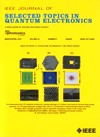Submission Deadline: August 1 (Mon), 2022
Hard Copy Publication: May/June, 2023
Call for Papers
The IEEE Journal of Selected Topics in Quantum Electronics (JSTQE) invites manuscript submissions in Photonic Electronic Co-Integration and Advanced Transfer Printing (PECATP) which is an ensemble of advanced field of modern Opto-Electronics system level driven development works, reflected by the core technology advancement in essence via integration in all levels. In specific relevance for this issue, it is the electronic and photonic integrated circuit (PIC), chip-lets in engine-level and module-levels, being architecture by large scale and continuously increasing functionalities in demand, and also for various wavelength covering many applications fields, through the either hybrid-, heterogenous, and/or monolithic integration. As examples, Heterogenous integrations have been done by direct bonding, transferring, or off-chip bonding, or even monolithic growth; in parallel, and photonic electronic integration have been implemented monolithically, and/or via chip-lets strategy taking advantage of the modern 2.5D/3D packaging developed pre-dominantly for electronic System-in-package Concept.
The IEEE Journal of Selected Topics in Quantum Electronics (JSTQE) invites manuscript submissions in the area of Photonic Electronic Co-Integration and Advanced Transfer Printing. The purpose of this issue of JSTQE is to highlight the recent progress in both research and development trend and industrial product implementation prospects, challenges and opportunities ahead, especially the new application demands and requirements on Photonic Electronic Co-Integration and Advanced Transfer Printing technology platforms and application demonstration status, especially for future products with new application demands, beyond the current industry focus on optical-interconnects centric transceiver or light sensor (e.g., LiDAR) alike. Areas of interest include (but not limited to):
• Photonics hybrid integration and advancement, e.g., in Si, InP, SiN, SiC, AlN, ….
• Hybrid Integrated materials, such as: InP, LiNbOx, VOx, Magneto-optic material, Phase-Change-Materials, etc.
• Heterogeneous integration technology, such as through: Growth, Bonding, Printing Transfer, etc.
• O-E Co-Integration Technology, e.g., Optical-, Opto-Electronics interposers, and chip-lets, Co-Packaging, Light-Source and
Detectors.
• Optical interconnects, telecommunications
• Microwave photonics
• Photonic sensors beyond typical wavelength, e.g., LiDAR, Chemical and Gas-sensor, medical Imaging (e.g., Soft-X-ray, Mid-IR)
• Optical Computing, AI and Deep-Learning
• Quantum Photonics and Applications
• Photonic Electronic Co-Integration, e.g., Co-Packaging, and/or Advanced Transfer Printing
• Product Development effort and Status
The Primary Guest Editor for this issue is Prof. Peter Ossieur, Ghent University, Belgium. The Guest Editors are: TBA The deadline for submission of manuscripts is August 1, 2022. Hardcopy publication of the issue is scheduled for May/June 2023. Unedited preprints of accepted manuscripts are normally posted online on IEEE Xplore within 1 week of the final files being uploaded by the author(s) on ScholarOne Manuscripts. Posted preprints have digital object identifiers (DOIs) assigned to them and are fully citable. Once available, the preprints are replaced by final copy-edited and XML-tagged versions of manuscripts on IEEE Xplore. This usually occurs well before the hardcopy publication date. These final versions have article numbers assigned to them to accelerate the online publication; the same article numbers are used for the print versions of JSTQE.

